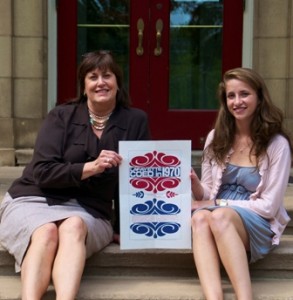
Diane Shaw, College archivist, and Sarah Shuster ’12 developed the College's 40 Years of Coeducation web site.
You’ve come a long way ladies…
At least that’s what Sarah Shuster ’12 (Queens, N.Y.) discovered while researching the 40th anniversary of coeducation at Lafayette this year.
When Lafayette’s Board of Trustees considered admitting women in 1968, some of the all-male students initially resisted the idea, saying they had come to an all-male school and they expected to graduate from one. Many alumni also expressed opposition.
“They were more about keeping traditions, and thought women would be a distraction,” says Shuster, who is double majoring in government & law and philosophy.
Working with Diane Shaw, College archivist and special collections librarian, as an EXCEL Scholar, Shuster conducted research and helped create the web site that documents Lafayette’s journey from an all-male college to a coed institution that welcomed 146 women in the fall of 1970. Of that number, 123 women were freshman and 23 transfer students. The web site contains newspaper and magazine articles, documents, photos, a timeline, and samples of interviews drawn from a collection of more than 50 oral histories, documenting Lafayette during a decade defined by the Vietnam War, Watergate, advances in civil rights, equal rights, and the first Earth Day.
Shuster and Elaine Stomber ’89, associate archivist, will give a talk about the web site, “Lafayette: Coed in 1970,” at 5 p.m. Friday, Oct. 1, in the Gendebien Room of Skillman Library. The lecture is one of many events celebrating Lafayette’s 40 years of coeducation taking place during the 2010-11 academic year.
“I wouldn’t have considered myself tech savvy before,” says Shuster, who will continue working on the project this fall. “I love that I was able to channel my creativity and was so grateful for the help I received from Information Technology Services to make my visions come alive on the screen.”
Shaw says Lafayette did try and make the new coeds feel welcome by installing bathtubs in the women’s dorms, providing sewing machines, and assigning roommates by size and weight “so they could share clothes.”
Despite occasional taunts and threats of panty raids by the male students, the first class of women excelled after posting high school grades and SAT scores higher than their male counterparts.
“It became very clear that the women were going to do just fine,” says Shaw.
Shuster says she has always been interested in “the women’s movement” which influenced her to work on a project that explored Lafayette’s decision to admit women.
“The fact that so many current students are not knowledgeable about the strife that women faced here, speaks for itself,” Shuster says. “It’s easy to forget the challenges women have overcome, but this is an occasion to be appreciative of those founding women.”
Shuster notes that gender inequities persist in the U.S. and abroad. “We’ve come far, but it’s not the end of the line,” she says. “There is still a lot of work left.”
The project began in 2003 and Shuster is actually the fourth student to work on the web site.
“Sarah’s role was to reorganize the collection, create the web site, and conduct additional interviews. She accomplished a great deal this summer, including moving us to digital interviews and posting our first sound files on the web,” says Shaw.
Shuster, whose dream job is to write for The New Yorker, says she enjoyed the “historical and research aspects, but was most intrigued by the very personal ‘Tell-me-your-story style,’ ” approach of the project. She’s proud that the web site is “such a useful resource.”

1 Comment
Comments are closed.